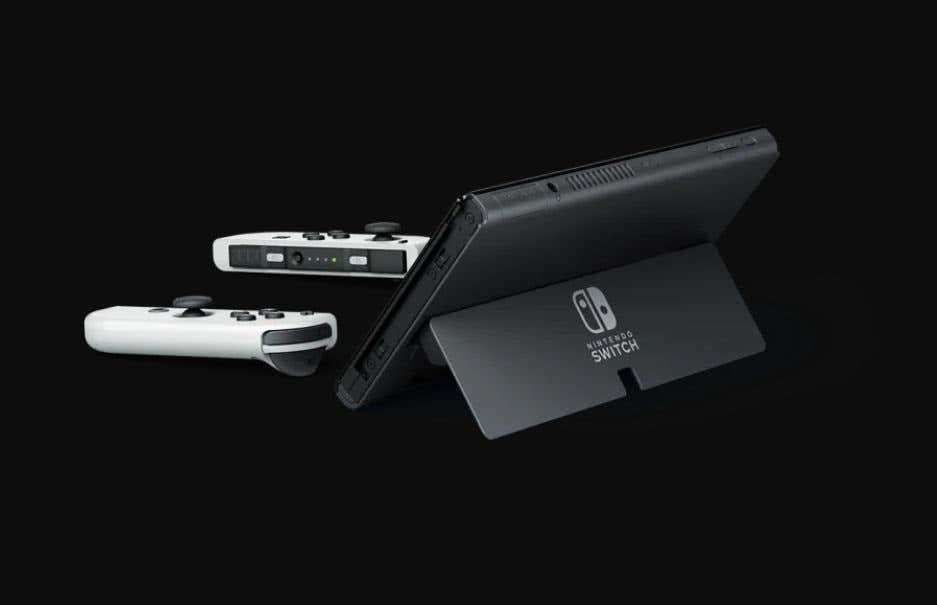We show you all the new features
Nintendo announced the new iteration of their Switch, dubbed the OLED model, on July 6th, 2021 via their Twitter account. Many people speculated about Nintendo announcing a new version of the Switch, but for many, the news did not match their expectations.
There are not many differences between the original Switch console and the new Nintendo Switch OLED model. Most of the changes come down to display, storage, and some other minor upgrades. Below you’ll find a detailed outline of each of these new features, and a final verdict on whether or not it’s worth a buy.
The Nintendo Switch OLED Screen
The all-new screen uses an OLED (Organic Light-Emitting Diode) screen in order to make the display on the Switch even better. It’s a 7-inch widescreen, making the games played on it look much more bright and crisp. By using OLEDs, the colors on the screen will be much more vibrant as well, resulting in deeper blacks and more detail in colors.
Compare this to the standard Nintendo Switch, which has only a 6.2-inch screen, and uses LCD (liquid crystal display). The Nintendo Switch Lite is even smaller, at 5.5 inches. All models of the Switch currently output at 720p in tabletop/handheld mode, despite differences in screen size.
Using an OLED screen also means that you can easily view what’s on the display from numerous angles. If you’re really into playing handheld, this can make the experience much more enjoyable as you don’t have to worry about viewing at exactly the right angle.
Storage Capacity
The Nintendo Switch OLED model boasts double the internal storage capacity of the original Switch, at 64GB. You can also still insert an SD card if you wish to increase your space, giving you potentially up to 2TB of space.
This is a great improvement over the standard Nintendo Switch, which only comes with 32GB of space out of the box. Especially for those who like to download their games digitally, this can make a world of difference. Even just a couple of the larger games the Switch has to offer could easily fill up this space, so double the amount is a welcome change.
A New Stand
The kickstand on the original Switch model left much to be desired, causing you to test your balancing skills every time you wanted to do some tabletop gameplay. It could also easily be broken due to its small width.
With the OLED model, the kickstand was entirely reimagined, and now spans the length of the system. It’s much sturdier than the original Switch kickstand, making it much easier to simply pop out and start up a game.
Battery Life
Nintendo Switch OLED screens are generally better at saving battery life, as they don’t need to unnecessarily light up parts of the screen that are supposed to be darker. This results in more efficient power usage. On Nintendo’s website, they state that the OLED model’s battery life is about the same as the standard model – 4.5 – 9 hours. However, keep in mind that the OLED model’s screen is significantly larger, meaning that even with this upgrade and increase in display quality, you won’t have to sacrifice any battery life for it.
Console Design
Between both the Nintendo Switch OLED model and the standard Nintendo Switch model, the design of the console itself is essentially the same. Both feature detachable Joycons, and the shape of the console remains similar, besides the OLED being only slightly taller and heavier.
As far as colors go, there are some differences there. Both systems will come in Neon red and blue color. However, where the standard Switch also had an all-grey color option, the OLED Switch will have a white option.
Docking the System
Both Nintendo Switch systems are able to connect to a separate dock, which allows you to play your games in TV mode via HDMI cable. However, there is an upgrade to the OLED Switch dock which now includes an ethernet port. This can provide players with a faster, wired internet connection, something the original Switch model didn’t include unless you bought the USB adapter.
Nintendo is also going to start selling the upgraded dock separately, so if you want this, you won’t need to buy the OLED Switch to get it. It also comes in white as opposed to the standard Switch’s grey dock.
Should You Buy the Nintendo Switch OLED Model?
Although it’s not the entirely redesigned Switch Pro many were hoping for, the OLED model does come with many important upgrades. But is it worth the $350 price point?
If you already have the original Switch, the upgrades are probably not drastic enough to warrant shelling out that much for a slightly better console. It may be worth it to wait until Nintendo comes out with something significantly different. Especially if you find yourself playing in TV mode more often than not, the OLED screen and other upgrades revolve more around handheld gameplay anyway.
However, if you don’t have the Switch console but are looking into buying one, considering the OLED model could be worth it. The original Switch currently runs around $299 at most retailers, so if you want to pay $50 extra for some upgrades, it’s a pretty good deal. If handheld gaming is what you’re most interested in with the Switch, you’ll likely get more enjoyment going with the OLED too.
Are you planning on buying the Nintendo Switch OLED model? Let us know in the comments.








